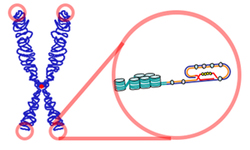Chromosome protection by telomeres and telomerase
In 2009, Elizabeth H. Blackburn, Carol W. Greider and Jack W. Szostak were jointly awarded a Nobel prize for their research into telomeres, which are found at the end of chromosomes, and their discovery of telomerase, the enzyme that maintains them.
Scientists had noticed that all of our chromosomes have similar sequences of DNA at their ends. These sequences, called telomeres, do not code for genes, but Blackburn, Greider and Szostak showed that they have a very important role.
 Blackburn and Szostak found that chromosomes without telomeres are protects them from degradation. Greider and Blackburn identified the enzyme that helps telomeres to protect the chromosomes – telomerase. Telomerase is unusual because it is made up of RNA as well as protein molecules. The RNA is complementary to the telomere sequence, which allows the telomeres to be copied efficiently. Without this RNA template, the cell’s machinery is unable to copy entire chromosomes, and they become shorter and shorter each time they are replicated.
Blackburn and Szostak found that chromosomes without telomeres are protects them from degradation. Greider and Blackburn identified the enzyme that helps telomeres to protect the chromosomes – telomerase. Telomerase is unusual because it is made up of RNA as well as protein molecules. The RNA is complementary to the telomere sequence, which allows the telomeres to be copied efficiently. Without this RNA template, the cell’s machinery is unable to copy entire chromosomes, and they become shorter and shorter each time they are replicated.
In later work, Blackburn, Greider and Szostak found that telomeres and telomerase play a major part in the ageing process – of cells and of entire organisms. Telomerase is very sensitive to mutations and telomere defects have now been implicated in a number of diseases. Greider showed that the telomeres would shorten in mice with only one functional copy of the telomerase gene or had the half the normal amount of telomerase. In contrast, cancer cells have been shown to have high telomerase activity, which is one of the reasons they can go on dividing indefinitely. These discoveries have led to a wealth of research into possible therapies that specifically target telomeres.
The majority of Blackburn, Greider and Szostak’s work used human and yeast cells, and some unicellular organisms. Their findings have now been tested across a range of animals, including mice and frogs, and research into telomere-based therapies for cancer and other diseases often makes use of mouse models.
Further reading
http://www.nobelprize.org/nobel_prizes/medicine/laureates/2009/popular-medicineprize2009.pdf
http://www.nytimes.com/2013/04/09/science/elizabeth-blackburn-molecular-biologist-charts-her-own-course.html?pagewanted=all&_r=0
http://www.laskerfoundation.org/awards/pdf/2006_b_blackburn.pdf
http://www.nytimes.com/2011/10/18/science/18conversation.html?pagewanted=all
Last edited: 27 August 2014 06:02
